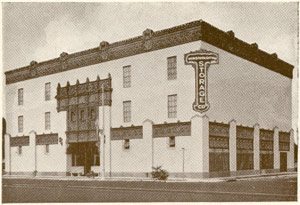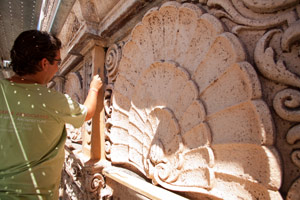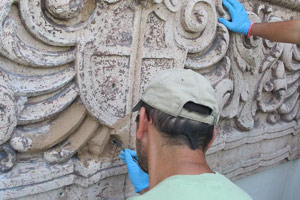A Facelift of Sorts
Wolfsonian Building Undergoes Conservation


Over the past year, scaffolding has been the most visible attribute of The Wolfsonian’s exterior. Fortunately, that scaffolding is coming down shortly, which will allow for unobstructed views of the newly preserved 1926 cast stone façade.
Fragments of the cast stone in the decorative portal above the entrance and the two tiers of friezes that run the width of the west and south façades were cracking, detaching and falling. The conservation firm of Rosa Lowinger & Associates (RLA) was hired to undertake the restoration.
The stone work is original to the building. Designed by Robertson and Patterson Architects and completed in 1927, The Wolfsonian’s Mediterranean Revival-style building was originally built for Washington Storage Co.
Wealthy snowbirds made Washington Storage one of their last stops before returning home for summer. Al Capone, the Duchess of Windsor, Milton Berle, Harvey Firestone and Carl Fisher stored their finery at Washington Storage. The building housed everything from cars to furs to furniture, artwork and silverware for their seasonal clientele.

Interestingly, the storage company was never air-conditioned. Instead, the company was a pioneer in using silicate gel to maintain 50 percent humidity around the clock on its airtight storage floors. And long before its incarnation as the home of The Wolfsonian – F.I.U., museum objects were stored in the building from the Bass Museum.
The building has undergone two renovations since it was built. The reinforced cast stone used on the building was originally developed in the 1880s in Europe and came to the U.S. in the early 20th century.
The cast stone elements were reinforced with steel. Over time, hairline cracks in the stone allowed moisture in, causing the steel to rust. When steel rusts it expands, which in turn leads to cracking and detachment of the cast stone.
The Wolfsonian’s restoration began in January 2011 and involved repairing damage to about 30 percent of the cast stone and applying anticorrosive coating and water repellant to the entire surface of the cast stone.

As with any repair, there were unanticipated challenges. The extent of the damage was more than anticipated, and two of the finials needed to be removed and reinstalled.
The work is now nearly complete, and the scaffolding will come down within weeks leaving behind a restored Wolfsonian-FIU museum for Miamians to enjoy and learn.


